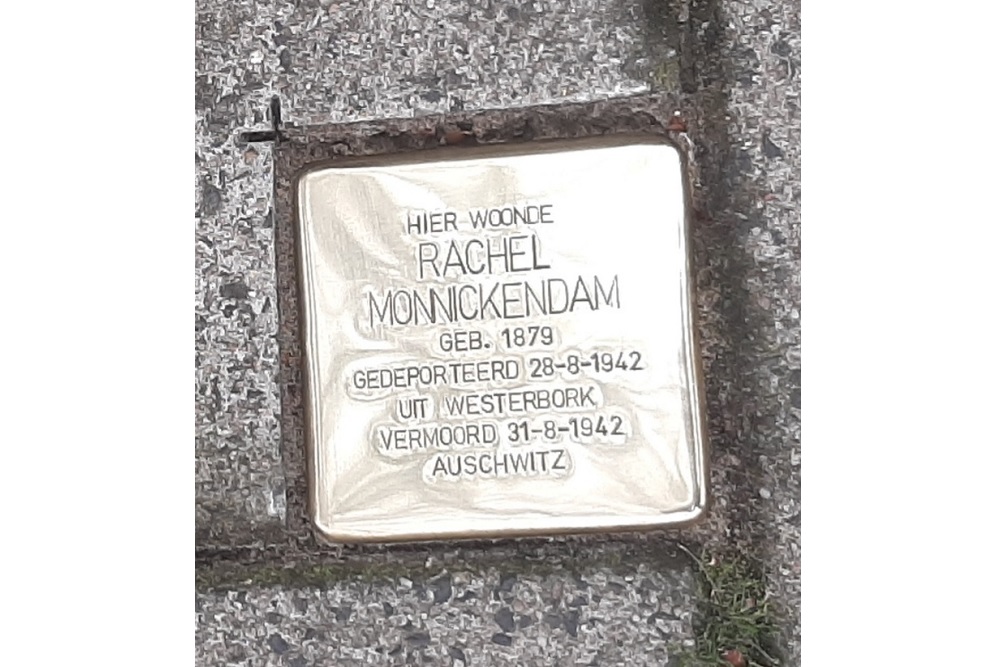Stumbling Stone Meeuwenstraat 26
STOLPERSTEIN / STUMBLING STONE
for:
Rachel Monnickendam
The German artist Gunter Demnig started placing the first Stolpersteine in 1997 in the Berlin's Kreuzberg district.
Meanwhile there are Stolpersteine in many countries.
It reminds the Holocaust in World War II.
A Stolperstein is a concrete stone of 10 x 10cm, with a brass plate on top, in which the name, date of birth and decease and also place of decease is punched into.
The Stolperstein gets a place in the pavement in front of the former house of the victim.
By doing this, Gunter Demnig gives a private memorial to each victim.
His motto is: 'A HUMAN BEING IS FORGOTTEN ONLY WHEN HIS OR HER NAME IS FORGOTTEN'.
Borne was the first town in the Netherlands in which Stolpersteine were placed.
This happened the 29-11-2007.
Rachel Monnickendam
May 25, 1879 (Amsterdam) - August 31, 1942 (Auschwitz)
Rachel Monnickendam was born on May 25, 1879 at 11 Reguliersbreestraat in Amsterdam. She was the second youngest child in the family of Roosje Rippe, born in Dordrecht, and the Amsterdam bookkeeper Nathan Meijer Monnickendam. Of the six children born into this family, Raphaël and Rebecca died young, so Rachel grew up with her older brothers Jacques and Martin and her younger sister Elisabeth. In May 1884 the family moved to the nearby Binnen Amstel 20. It is in this house that her brother, the well-known painter Martin Monnickendam, made a drawing in 1892 of Elisabeth with sewing at the table and Rachel playing the violin in the background. Playing the violin was more than just a hobby because in various sources she is referred to as a violinist. In addition, in 1905 she was registered as a nurse's apprentice at the Binnengasthuis in Amsterdam and as a nurse she worked in the Home for Women in The Hague (1918).
The Monnickendam children have lived in many different places in the Netherlands and abroad. Rachel, for example, spent a few months in Berlin, but also in America and France. Martin lived as a painter in Paris, Jacques temporarily lived in Marburg and Cologne and Elisabeth in Aachen.
From her position as a nurse, she signed with Zuster Rachel Monnickendam, she placed in the Algemeen Handelsblad of 19 December 1919 a call for Dutch women to make clothes for children in Hungary and Vienna, where the population was serious after the First World War weakened and in 1919 was ravaged by one of the harshest winters ever. That call was in line with Rachel's knowledge of making clothes and various sources indeed listed (model) seamstress as her profession. On June 4, 1938, Rachel settled as a single woman from Amsterdam at 26 Meeuwenstraat in Haarlem. At the beginning of August of that year, her sister Elisabeth, who worked as a government telephone operator, came to live with her, but on the 19th of that same month Elisabeth moved to the municipality of Ede in Gelderland. There she was admitted as a long-term patient to a sanatorium on the Boslaan in Lunteren.
Rachel Monnickendam was transferred from the Meeuwenstraat to the Westerbork transit camp on 26 August 1942 and deported to Auschwitz two days later. There she was probably killed immediately after arrival on August 31, 1942. Her eldest brother Jacques had already died in 1922. Her other brother, the painter Martin, died of pneumonia in his home in Amsterdam in January 1943. Rachel's sister Elisabeth was murdered in Sobibor in April 1943.
Transport from Westerbork 28 August 1942.
Died in Auschwitz on August 31, 1942.
She was 63 years old.
Do you have more information about this location? Inform us!
Source
- Text: Reini Elkerbout
- Photos: Piet Sebregts
Nearby
Museum
Point of interest
- Ripperda Barrack Haarlem - Haarlem
- Former House of Hannie Schaft, Haarlem - Haarlem
- Branch House NSSF-MTS Haarlem - Bloemendaal
Monument
- Memorial Execution 12 February 1945 - Haarlem
- War Memorial Spaarndam - Spaarndam
- War Memorial Santpoort - Santpoort
Cemetery
- Dutch War Grave Roman Catholic Cemetery St. Bavo - Haarlem
- Dutch War Graves Roman Catholic Cemetery St. Barbara - Haarlem
- Dutch War Graves General Cemetery Akendam - Haarlem
Remembrance Stone
- Stumbling Stones P.C. Hooftstraat 4 - Haarlem
- Stumbling Stones Rechthuisstraat 40 - Haarlem
- Stumbling Stone Rijksstraatweg 154 - Haarlem
Fortification
- Group Shelter Type 1918/I Spaarndam - Spaarndam
- Group Shelter Type 1918/I Spaarndam - Spaarndam
- Group Shelter Type 1918/I Spaarndam - Spaarndam





